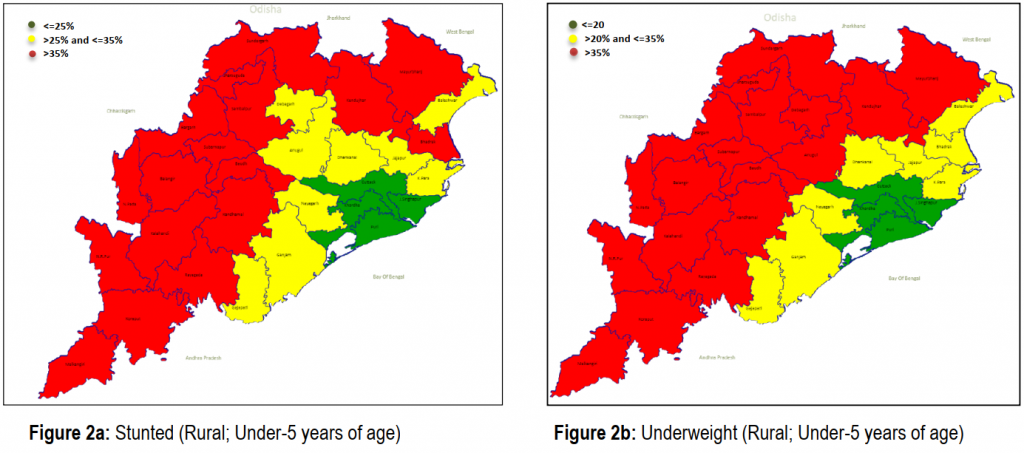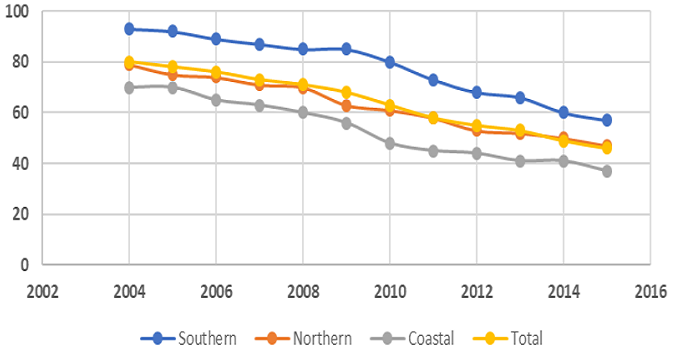
NFHS – 4 provides, for the first time a district level data on nutritional status of children below the age of 5 years. This provides an excellent and timely opportunity to plan for eradication of child malnutrition at the district level. A quick preliminary analysis of the district level child malnutrition levels, reveals certain important aspects. This is presented below.
Table 1 presents the data on wasting, underweight and stunting in a color coded form. These three aspects of child malnutrition are interrelated. This relationship is brought out in Figure 1a. There is a clear linear relationship between underweight on one hand and stunting and wasting on the other. The very robust nature of both the linear regressions (R-square of 0.88 for stunting and 0.76 for wasting), has a bearing on programme implementation. Collecting good quality data on underweight can give us a good indication of the levels of wasting and stunting as well. Hence we need not initiate routine measurement of height through Anganwadi workers or ASHAs. The task of estimating stunting can be left to periodical NFHS surveys which will now be taking place at 3 year intervals . At Anganwadi level recording weight and use of MUAC tapes to identify wasting will be adequate at this stage



It is useful to rearrange Table – 1 in descending order of underweight. This brings out the low levels of severe wasting in coastal belt. Districts which have low figures of severe wasting have mostly got other parameters right, and, more importantly, where this has gone wrong, other parameters have gone wrong too. Table -2, quite clearly, brings out the importance of reducing the incidence of severe wasting. It also shows the regional contiguity of the parameters and the need for separate planning for different districts.

The coastal districts of Jagatsinghpur, Cuttack, Kendrapada, Puri and Khordha have done well in all parameters. While Ganjam shows better result in underweight, it needs to improve on rest of the parameters. The case of Nayagarh is interesting, a modest reduction in underweight and stunting (not color coded purposefully) would have put it in the league of the other coastal districts. Baleshwar and Jajpur are somewhat of a surprise and may need a closer scrutiny.
The Angul, Jharsuguda, Debgarh belt has intermediate position along with Gajpati, which shows a low incidence of wasting. Whether this is consistent or a one off case needs to be seen. On the other end of the spectrum, districts of Southern and some of the districts in Western Odisha have not fared well. Mayurbhanj and Keonjhar two contiguous tribal districts have done relatively better in reducing wasting, but not other parameters.
The regional dimension of the situation can be readily appreciated if we look at the Odisha map as brought in Figure 2a-2d below. The maps clearly show three separate clusters in green, yellow and red corresponding to the least, middle level and high malnutrition.


There is a very clear case for taking Dhenkanal, Nayagarh, Gajapati and Ganjam belt from the yellow zone to the green zone. So is the case with the Jajpur – Bhadrak – Balasore zone.
One area of focus would be the Jagatsinghpur, Kendrapada and Cuttack belt which is ‘closest to the goal-post’ of removing moderate and severe malnutrition. These are “positive deviants” within a state which we need to identify, celebrate and push systematically towards becoming malnutrition free. Such a shift of emphasis from high burden to low burden districts is necessary given the goal of achieving a malnutrition free India with emphasis on district level planning, convergent action and monitoring.
Having identified these districts, we next look at various correlates of malnutrition and find out the district which have performed well above the state average in respect of maximum number of correlates. NFHS-4 provides data in respect of a number of such parameters. We have selected 43 such parameters and have arranged these in the life cycle sequence starting from the new born to the adolescent girl and the pregnant mother.
The parameters have further been organized into major clusters i.e. child anthropometry, infant and young child feeding practices, immunization, management of diarrhoea and ARI, women’s marriage, health, ante natal care, post-natal care and educational background among others. These indicators have again been colour coded depending upon their levels with level to the state averages, and in some cases where the state average is itself rather low, the colour coding has been done in terms of absolute performance.
Jagatsinghpur and Puri have the largest number of well performing indicators, not Cuttack and Khordha. Further, these two districts perform below par mainly in the IYCF segment, i.e. early initiation of breastfeeding, and adequacy of diet to young children. Other two important parameters are the sanitation coverage and mothers with 10 plus years of schooling.
The above analysis is represented through radar diagram where each cluster has been assigned certain score and the achievement of the district marked against the full score. While doing an individual district analysis, it is also possible to do a full parameter radar diagram. Such a radar diagram allows the district to prioritise its areas of intervention. The issue of relative weightage of these parameters will however, remain. That will be taken up separately.

Burden of the problem
We now turn to an interesting aspect of the problem- the burden in absolute numbers. How many children are there likely to be moderately or severely malnourished? Every district will like to know this. We have used an easy but reasonably accurate estimate based on the census 2011 data for children in the 0-6 year age group. This number represents seven cohorts. As such 5/7th of this number will give rough estimate of the children below 60 months in the given district. Using NFHS-4 data we estimate number of malnourished children.
Table 3 shows that Jagatsinghpur and Puri have the least burden of malnourished children in absolute number. In fact, the number of severely wasted children in both the districts is just below 3000. The corresponding figure for moderately wasted is about 9,000 and 12,000 respectively while children that are underweight are about 12,000 and 18,000 respectively.

The average number of children within most Anganwadis will be well below a double digit figure. If we look at the ICDS project wise figure e.g. the 8 blocks of Jagatsinghpur, the numbers will be even more manageable even if we use the % underweight figures from an earlier survey CCM-II done for Odisha in 2011 (Table 4).
It can be nobody’s case that these districts cannot take up the task of reducing malnutrition in a campaign mode and achieve early results. The time to begin this is NOW !

Three Regions in Odisha
We need to be cautious however in treating the state averages as a monolith since these hide considerable regional variety. An analysis of the IMR data from the SRS as per the NSSO regions will show that the situation in southern Odisha is a matter of concern while the coastal region has done much better (comparable to southern states) while the northern region is close to state averages.
Figure 4 clearly shows that the gap between the southern and the coastal region is not narrowing down. In fact, it has widened in relative terms (Table – 5). The gap was 23 points in 2004 when state IMR was as high as 80. The gap still remains at 20 points even when the state IMR has come down to 46 in 2015. This is one region of concern where we need to focus on.


We can also use the comparative approach for comparing the IMR trends among the three regions at comparable levels, but at different time periods. A look at the Table 6 shows that the southern regions lags the northern region by about 4 years.
The regional disparity in terms of malnutrition and IMR is further corroborated by the map of figures for moderate and severe stunting based on the district wise data from NFHS-4. This very clearly brings out the need to take the malnutrition issue in the southern region and the tribal region more seriously.

Authors
Dr. Ayushi Jain & Prof. Satish B Agnihotri
Ayushi Jain has completed her a PhD in CTARA, IIT- Bombay.
Prof. Satish B Agnihotri is Emeritus Fellow CTARA at IIT Bombay.
Suggested citation: Agnihotri, S. B., & Jain, A. (2021). NFHS-4 data analysis at district level for child malnutrition in Odisha. Nutrition Group, IIT Bombay.
